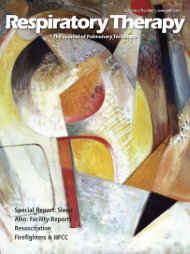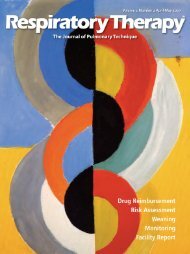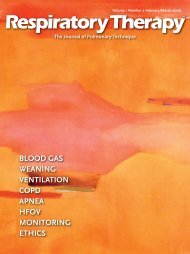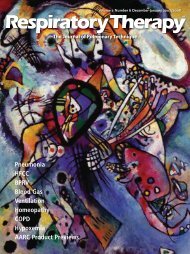RT 02-03 JJ07 main web - Respiratory Therapy Website
RT 02-03 JJ07 main web - Respiratory Therapy Website
RT 02-03 JJ07 main web - Respiratory Therapy Website
Create successful ePaper yourself
Turn your PDF publications into a flip-book with our unique Google optimized e-Paper software.
intermittent pauses in respiration, as witnessed by a bed<br />
partner, associated with 2) excessive daytime sleepiness (EDS).<br />
Given that patients often deny the latter, standardized<br />
questionnaires such as the Epworth Sleepiness Scale (ESS) 70 or<br />
the Functional Outcome Sleep Questionnaire (FOSQ) 71 are<br />
useful tools to assess EDS. The ESS asks the patients to rate<br />
their chances to fall asleep during periods of relaxation or<br />
inactivity (such as reading, watching television), but also in<br />
more active settings (driving a car, sitting and talking to<br />
someone). EDS is by far the most frequent daytime symptom of<br />
OSA, whereas nocturnal symptoms include restlessness,<br />
nocturia, excessive salivation and sweating, gastroesophageal<br />
reflux, as well as headache and dry mouth or throat in the<br />
morning on awakening. Furthermore, the clinical picture<br />
frequently includes obesity and hypertension, and, in those<br />
patients who are not obese, special facial abnormalities which<br />
narrow the upper airway, such as retrognathia or micrognathia.<br />
However, it should be kept in mind that OSA may not be<br />
immediately apparent, but might present in an atypical fashion,<br />
with irritability, tiredness, disrupted sleep, difficulty<br />
concentrating, difficulties accomplishing tasks and generally<br />
decreased psychomotor performance. 12 Women are more likely<br />
to present with these symptoms, 22,72,73 and have been suggested<br />
to be particularly underdiagnosed because of their atypical<br />
symptoms. 74 The importance of the sleep-wake complaints in a<br />
patient’s depressive profile, and the onset of those complaints<br />
prior to the development of the depressive psychopathology<br />
should draw the clinician’s attention to a potential underlying or<br />
coexisting OSA. 75<br />
Third, particular attention should be paid to depressive patients<br />
who are resistant to treatment. In this case, OSA should be<br />
excluded as a major underlying contributing factor, 76 as<br />
treatment of OSA could improve not only the compliance to<br />
pharmacological antidepressant treatment, but also the<br />
treatment response rate for depression. 77 Fourth, comorbid<br />
disorders of OSA may also catch the attention of the treating<br />
psychiatrist. In addition to the outlined association with the<br />
metabolic syndrome, Farney et al. observed that the likelihood<br />
of OSA increased significantly when either antihypertensive or<br />
antidepressant medications had been prescribed. 78<br />
Depressed patients with a suspected OSA should be referred to<br />
a sleep disorders center for evaluation by nocturnal<br />
polysomnography, to confirm the diagnosis of OSA or the<br />
presence of other forms of sleep disordered breathing, such as<br />
the upper airway resistance syndrome. 79 This is of particular<br />
importance, as some of the adjunct treatments to the current<br />
pharmacological treatment of depression may actually<br />
exacerbate the condition.<br />
If the diagnosis of OSA has been established in a depressed<br />
patient, and treatment has been initiated, close follow-up of the<br />
improvement of the depressive symptoms might give some<br />
indications as to the extent to which the presence of OSA may<br />
have contributed to the depressive symptomatology. However,<br />
as Baran and Richert point out, 41 the aforementioned diagnostic<br />
challenge of a depressive syndrome in the presence of OSA<br />
currently re<strong>main</strong>s unresolved.<br />
On the other hand, systematic assessment of depressive<br />
symptoms with standardized clinical questionnaires in OSA<br />
patients is generally part of the evaluation process in all major<br />
sleep disorder centers. However, as these questionnaires have<br />
not been specifically designed to assess depression in OSA<br />
patients, 80 they might be inappropriate to assess depression in<br />
this population, given that it is still unclear if OSA and<br />
depression display a true comorbidity or only share similar<br />
symptoms. 41 Typically, patients with severe depressive<br />
symptoms should be referred to a psychiatrist, particularly if<br />
such symptoms do not regress or if fatigue lingers after efficient<br />
treatment of OSA. 81<br />
Conclusion<br />
Recent studies underscore the existence of a complex<br />
relationship between depression and OSA in terms of clinical<br />
presentation, underlying pathophysiology and treatment. It<br />
should incite the treating psychiatrist to be highly aware of a<br />
possibly underlying or coexisting OSA in depressed patients. Up<br />
to 20% of all patients presenting with a diagnosed depressive<br />
syndrome may also have OSA, and vice versa. This relationship<br />
might vary widely, depending on age, gender, AHI cut-off and<br />
general demographic and health characteristics of the<br />
population under investigation. Future clinical research in this<br />
area should specifically examine depressed patient populations,<br />
taking into account the different sub-type of mood disorders,<br />
and investigate a broader range of depressive symptomatology<br />
in OSA patients. Basic research should further investigate the<br />
causal relationship between depression and OSA, as well as the<br />
potential mechanisms by which both disorders may interact.<br />
References<br />
1 Gastaut H, Tassinari CA, Duron B: [Polygraphic study of<br />
diurnal and nocturnal (hypnic and respiratory) episodal<br />
manifestations of Pickwick syndrome]. Rev Neurol (Paris)<br />
1965, 112:568-579.<br />
2 Guilleminault C, Tilkian A, Dement WC: The sleep apnea<br />
syndromes. Annu Rev Med 1976, 27:465-484.<br />
3 Sleep-related breathing disorders in adults:<br />
recommendations for syndrome definition and measurement<br />
techniques in clinical research. The Report of the American<br />
Academy of Sleep Medicine Task Force. Sleep 1999, 22:667-<br />
689.<br />
4 Ali NJPDSJR: The prevalence of snoring, sleep disturbance<br />
and sleep related breathing disorders and their relation to<br />
daytime sleepiness in the 4-5 year old children. Am Rev<br />
Respir Dis 1991, 143:A381.<br />
5 Young T, Palta M, Dempsey J, Skatrud J, Weber S, Badr S:<br />
The occurrence of sleep-disordered breathing among middleaged<br />
adults. N Engl J Med 1993, 328:1230-1235.<br />
6 Krieger J, Mangin P, Kurtz D: [<strong>Respiratory</strong> changes during<br />
sleep in healthy elderly subjects (author’s transl)]. Rev<br />
Electroencephalogr Neurophysiol Clin 1980, 10:177-185.<br />
7 Carskadon MA, Dement WC: Respiration during sleep in the<br />
aged human. J Gerontol 1981, 36:420-423.<br />
8 Ancoli-Israel S: Epidemiology of sleep disorders. Clin Geriatr<br />
Med 1989, 5:347-362.<br />
9 Ancoli-Israel S, Kripke DF, Klauber MR, Mason WJ, Fell R,<br />
Kaplan O: Sleep-disordered breathing in community-dwelling<br />
elderly. Sleep 1991, 14:486-495.<br />
10 Guilleminault C, Eldridge FL, Tilkian A, Simmons FB,<br />
Dement WC: Sleep apnea syndrome due to upper airway<br />
obstruction: a review of 25 cases. Arch Intern Med 1977,<br />
137:296-300.<br />
11 Reynolds CF, Kupfer DJ, McEachran AB, Taska LS, Sewitch<br />
DE, Coble PA: Depressive psychopathology in male sleep<br />
apneics. J Clin Psychiatry 1984, 45:287-290.<br />
60 <strong>Respiratory</strong> <strong>Therapy</strong> Vol. 2 No. 3 � June-July 2007











